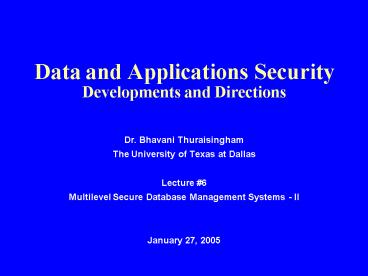Data and Applications Security Developments and Directions - PowerPoint PPT Presentation
1 / 20
Title:
Data and Applications Security Developments and Directions
Description:
Overview of MLS/DBMS Designs (Concluded) ... MLS/DBMSs have been designed and developed for various kinds of database systems ... – PowerPoint PPT presentation
Number of Views:76
Avg rating:3.0/5.0
Title: Data and Applications Security Developments and Directions
1
Data and Applications Security Developments and
Directions
- Dr. Bhavani Thuraisingham
- The University of Texas at Dallas
- Lecture 6
- Multilevel Secure Database Management Systems -
II - January 27, 2005
2
Outline
- MLS/DBMS Designs and Prototypes
- Challenges
- Multilevel Secure Data Models
- MLS/DBMS Functions
- Directions
3
Overview of MLS/DBMS Designs
- Hinke-Schaefer (SDC Corporation) Introduced
operating system providing mandatory access
control - Integrity Lock Prototypes Two Prototypes
developed at MITRE using Ingres and Mistress
relational database systems - SeaView Funded by Rome Air Development Center
(RADC) (now Air Force Rome Laboratory) and used
operating system providing mandatory access
control and introduced polyinstation - Lock Data Views (LDV) Extended kernel approach
developed by Honeywell and funded by RADC and
investigated inference and aggregation
4
Overview of MLS/DBMS Designs (Concluded)
- ASD, ASD-Views Developed by TRW based on the
Trusted subject approach. ASD Views provided
access control on views - SDDBMS Effort by Unisys funded by RADC and
investigated the distributed approach - SINTRA Developed by Naval Research Laboratory
based on the replicated distributed approach - SWORD Designed at the Defense Research Agency in
the UK and there goal was not to have
polyinstantiation
5
Some MLS/DBMS Commercial Products Developed
(late 1980s, early 1990s)
- Oracle (Trusted ORACLE7 and beyond)
Hinke-Schafer and Trusted Subject based
architectures - Sybase (Secure SQL Server) Trusted subject
- ARC Professional Services Group
(TRUDATA/SQLSentry) Integrity Lock - Informix (Informix-On-LineSecure) Trusted
Subject - Digital Equipment Corporation (SERdb) (this group
is now part of Oracle Corp) Trusted Subject - InfoSystems Technology Inc. (Trusted RUBIX)
Trusted Subject - Teradata (DBC/1012) Secure Database Machine
- Ingres (Ingres Intelligent Database) Trusted
Subject
6
Some Challenges Inference Problem
- Inference is the process of forming conclusions
from premises - If the conclusions are unauthorized, it becomes a
problem - Inference problem in a multilevel environment
- Aggregation problem is a special case of the
inference problem - collections of data elements
is Secret but the individual elements are
Unclassified - Association problem attributes A and B taken
together is Secret - individually they are
Unclassified
7
Some Challenges Polyinstantiation
- Mechanism to avoid certain signaling channels
- Also supports cover stories
- Example John and James have different salaries
at different levels
8
Some Challenges Covert Channel
- Database transactions manipulate data locks and
covertly pass information - Two transactions T1 and T2 T1 operates at Secret
level and T2 operates at Unclassified level - Relation R is classified at Unclassified level
- T1 obtains read lock on R and T2 obtains write
lock on R - T1 and T2 can manipulate when they request locks
and signal one bit information for each attempt
and over time T1 could covertly send sensitive
information to T1
9
Multilevel Secure Data Model Classifying
Databases
10
Multilevel Secure Data Model Classifying
Relations
11
Multilevel Secure Data Model Classifying
Attributes/Columns
12
Multilevel Secure Data Model Classifying
Tuples/Rows
13
Multilevel Secure Data Model Classifying
Elements
14
Multilevel Secure Data Model Classifying Views
15
Multilevel Secure Data Model Classifying
Metadata
16
MLS/DBMS FunctionsOverview
17
MLS/DBMS FunctionsSecure Query Processing
18
MLS/DBMS FunctionsSecure Transaction Management
19
MLS/DBMS FunctionsSecure Integrity Management
20
Status and Directions
- MLS/DBMSs have been designed and developed for
various kinds of database systems including
object systems, deductive systems and distributed
systems - Provides an approach to host secure applications
- Can use the principles to design privacy
preserving database systems - Challenge is to host emerging secure applications
including e-commerce and biometrics systems

